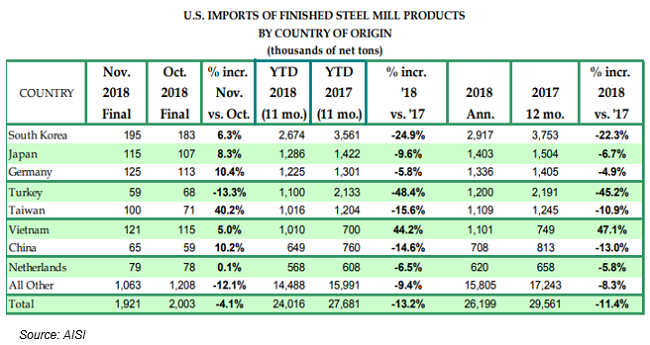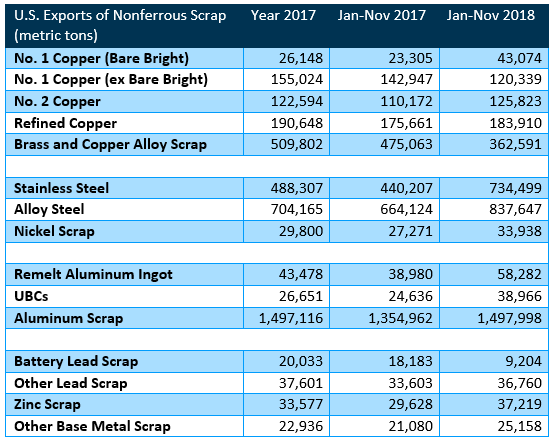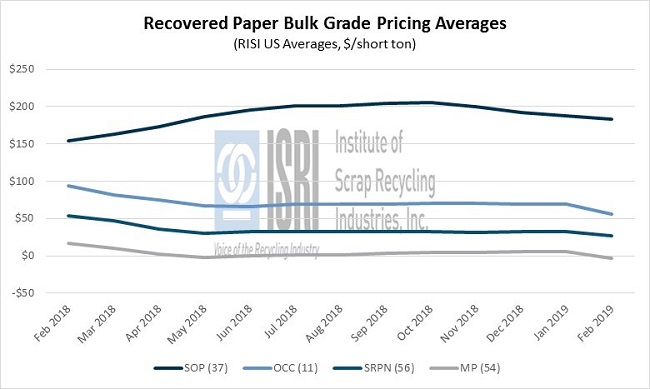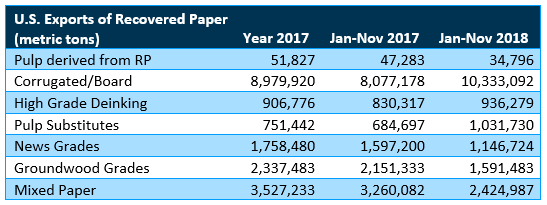Ferrous – According to the Federal Reserve’s report last week, total U.S. industry capacity utilization declined from 78.8% in December to 78.2% in January. Capacity utilization in the U.S. steel sector for the week ending February 16 came in at 81.0% according to the American Iron and Steel Institute.
That compares to a capacity utilization rate of 81.5% the prior week but 77.9% one year ago. For the year-to-date, AISI reports that U.S. steel production is up 8.4% to 12.737 million net tons.
AISI also reports that U.S. finished and total steel imports during Jan-Nov 2018 declined 10.8% and 13.2%, respectively, as compared to the corresponding period in 2017. By product, the biggest YTD percentage declines in U.S. imports included heavy structural shapes (-34%), wire rod (-30%), and cold-rolled sheet (-23%). Imports of finished steel mill products are reportedly down sharply this year from Turkey (-48%), South Korea (-25%), Taiwan (-16%), and China (-15%), the association reports.

Nonferrous – Late last week, LME 3-mo. and cash copper prices were trading higher around $6,180 per metric ton. In comparison, 3-mo. copper was trading $30 a ton higher than cash one month ago as traders may be lowering their copper price expectations amid indicators of slowing Chinese economic growth. On the aluminum front, Bob Tita of the Wall Street Journal spoke about falling prices for Twitch and Zorba in his research on current scrap metal trends. Aluminum prices on the LME and SHFE have declined and Fastmarkets MB’s Aluminum Spotlight reported that monthly aluminum production in China advanced to 3.025 million tons in November. According to that Fastmarkets’ report, as of late January “…the latest Commitment Of Traders’ Report {shows} LME aluminium had the largest net short fund position in the base metals complex. Stale-long liquidation pushed its gross long position down to just 61,305 lots at the end of 2018, a contrast to its May high of 122,629 lots. Confident sellers increased their bearish exposure to an annual high of 79,870 lots in 2018, an indication that overall sentiment towards the light metal is firmly bearish.” Here’s the reported trend in U.S. nonferrous scrap exports through November:

Paper and Plastic –

Prices softened at the beginning of 2019 as Chinese demand tailed off well in anticipation of the Lunar New Year holidays. Given the limitations on recovered paper imports, this is likely to become an annual trend unless Chinese trade policy changes or significant production capacity comes online outside of Asia.

U.S. recovered paper export data from the Commerce Department show that buyers have been making the shift to higher quality. While the increase in OCC from Mixed Paper was expected due to the Chinese import restrictions, the increase in deinking and pulp substitute grades is also noteworthy. This change indicates that processing improvements are creating a new bar for the industry. Environmentalists may become concerned about the pricing of mixed paper in that landfilling becomes a more attractive option to improve marginal costs on the processor.

The Paper Recycling Promotion Center (PRPC) of Japan shared some of their trade current trade data with ReMA on Japanese RP exports to China. According to Nobuyuki Kanatani of the PRPC, Chinese buyers were aggressively increasing their demand of Japanese recovered paper and move on the market with little to no vetting. Many Japanese paper companies were concerned about fiber shortages during H2 2018. Since U.S. exports of news grades to China are down nearly 60% over the year while Japanese exports went up 246%, it is evident that Chinese buyers prefer source separation as an indicator of quality.

The demand void created by the import ban on scrap plastics to China has been evident in the export data from the U.S. Census Bureau. Annual declines appear to be less than half for all polymer categories. Since China was previously the destination for nearly two-thirds of these exports, it’s a testament to the expansion of alternative markets that the declines were less than 50% on the year over year comparison. However, it may be just as instructive to look at the imports to get a better picture of what’s going on.

According to industry participants, scrap HDPE plastics have been dealing with a supply crunch which has been supported by sustained prices reviewed at RecyclingMarkets.net. A further look also showed that PET markets had been more robust in 2018, enough so that the U.S. was a net importer of PET scrap rather than an exporter.
For more information, please contact ReMA Research Analyst Bernie Lee.
Back to Main